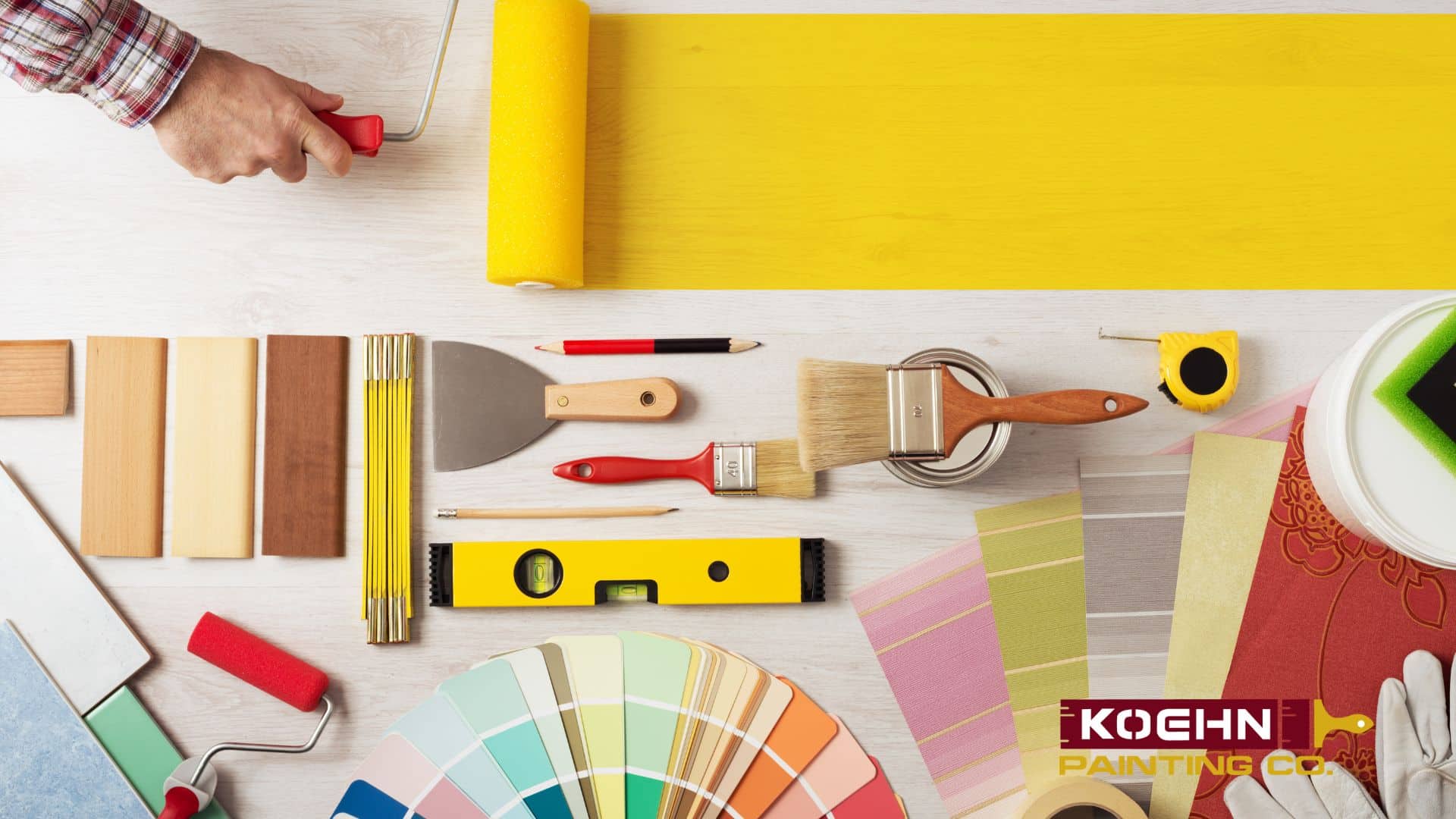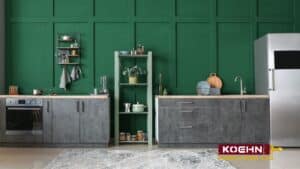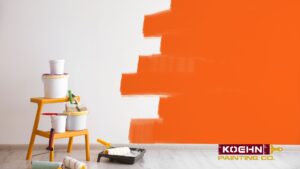Table of Contents
ToggleAchieving the perfect look and functionality for any space often depends on more than just color, such as choosing the right interior paint finishes, which play an equally important role in shaping a room’s aesthetics, durability, and maintenance requirements.
Not all rooms are the same, and the paint finish chosen should reflect each space’s unique demands. For instance, high-gloss finishes are ideal for high-traffic areas because they are easy to clean. Flat and matte finishes are excellent at masking wall imperfections in more intimate atmospheres, such as bedrooms or living rooms.
Not being aware of these differences between paint finishes can make owners choose a finish based purely on color preferences rather than practicality, leading to premature wear, increased maintenance, and, overall, bad results.
Understanding Paint Finishes and Sheens
Let’s start with the basics: What is a paint finish? In short, it is the outer layer of paint applied to a surface. It serves two main purposes: protection and decoration. So, in addition to making a room look good, it also shields surfaces from wear, weather, and aging.
Historically, paint finishes were tailored to the materials they covered:
- Oil paints were used on timber, metal, and plaster for durability and a polished look.
- Water-based paints like limewash and distempers were common for plaster and masonry, offering a simpler, flat finish.
- Decorative techniques like graining, marbling, and stenciling added flair, often inspired by trends or a building’s purpose.
But here’s where things get more nuanced: paint finishes differ not only in material or purpose but also in sheen.
What is Paint Sheen?
Sheen refers to the level of shine or reflection in the paint once it dries. It’s like the personality of the finish, giving it either a smooth, soft vibe or a glossy, polished look. While the finish defines the type of paint and its purpose (protective, decorative, or both), the sheen determines its appearance and functionality in different spaces.
Picking the wrong paint finish for a room or surface can lead to frustrating (and expensive) re-dos. But understanding how finishes work and why they matter can save you both time and money.
Here’s the golden rule: the shinier the finish, the tougher and more durable it is. But there’s more to it than just durability. Not all finishes are interchangeable, and choosing the right one depends on the space, its purpose, and the look one’s going for.
Each type of finish is designed for specific situations, balancing durability, aesthetics, and practicality. To make the most of a painting project, it’s recommended to be aware of the different types of paint finishes and why each one matters.
Types of Paint Finishes
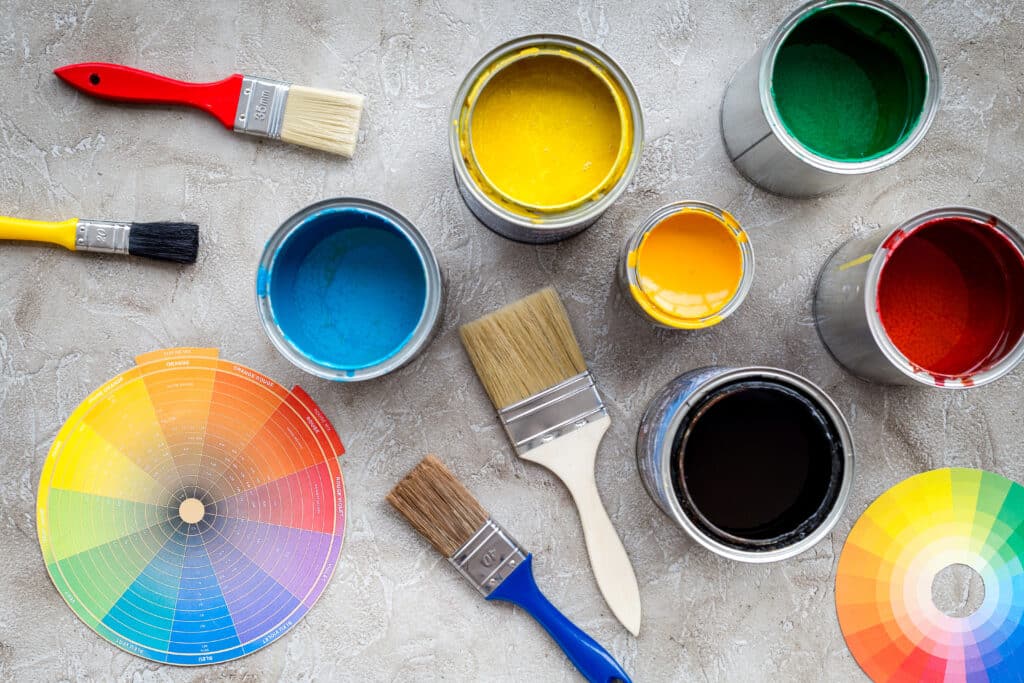
As mentioned above, the different types of paint finishes highlight the importance of making an informed decision. Since each finish has specific qualities that make it better suited for certain spaces, surfaces, and functions, the choice will depend on the type of area being worked on. Paying attention to these differences can help avoid costly mistakes and ensure the space looks great while performing even better.
While we dive into interior paint finishes for specific purposes—like durability, maintenance, light, and others—let’s break down the five main types of paint finishes and what makes each unique.
#1 Flat or Matte Finish
Flat or matte paint has no shine, creating a smooth, understated appearance. Its non-reflective nature makes it ideal for concealing surface imperfections like cracks or uneven textures. Plus, it offers excellent coverage, which can save time and paint. However, flat finishes are less durable than others and don’t hold up well to cleaning or scrubbing.
In short:
- No light reflectivity
- Excellent for hiding imperfection
- Provides smooth, even coverage
- Not quite ideal for areas requiring frequent cleaning
#2 Eggshell Finish
Eggshell has a subtle sheen that adds a soft, polished look without being overly reflective. It offers more durability than flat paint and can handle light cleaning, making it a great option for surfaces that need a touch of resilience without sacrificing elegance.
Basically:
- Low light reflectivity with a slight sheen.
- Hides minor surface flaws.
- Easier to clean compared to flat finishes.
- Strikes a balance between durability and subtle aesthetics.
#3 Satin Finish
Satin paint features a velvety texture and a noticeable but not overpowering sheen. It is more durable than eggshell and stands up well to moisture and cleaning, making it suitable for spaces that require regular upkeep. Satin finishes, however, are less forgiving when it comes to application flaws, as they can highlight brush or roller marks.
In essence:
- Mredate light reflectivity with a soft sheen
- Durable and moisture-resistant.
- Easy to clean and maintain.
- Requires careful application to avoid visible marks.
#4 Semi-Gloss Finish
Semi-gloss paint offers a noticeable shine and is highly durable. Its smooth, reflective surface is resistant to stains and moisture, making it an excellent choice for surfaces that experience heavy use or require frequent cleaning. However, its high sheen can emphasize imperfections, so consider proper preparation.
In essence:
- High light reflectivity.
- Extremely durable and easy to clean.
- Perfect for surfaces that endure frequent contact.
- Highlights surface flaws, so prep work is crucial.
#5 High-Gloss Finish
High-gloss paint is the shiniest and most reflective finish available. Its durability and stain resistance make it ideal for surfaces that experience heavy use. While it creates a striking visual impact, high-gloss paint requires meticulous surface preparation, as it highlights every detail, good or bad.
In essence:
- Superior light reflectivity with a mirror-like shine.
- Exceptionally durable and resistant to wear and tear.
- Ideal for creating bold visual accents.
- Demands flawless surface preparation to achieve a polished result.
Each of these finishes serves a specific purpose, offering a range of options from understated elegance to bold durability. When owners focus on the qualities of each finish, they leverage a more tailored choice to meet each space’s functional and aesthetic needs.
Key Factors to Consider When Choosing a Paint Finish
Since not all paint finishes serve the same purpose, it’s essential to consider how different factors impact the final decision. Here’s what to keep in mind:
- Durability and maintenance: Glossy finishes are highly durable and easy to clean, making them perfect for areas prone to wear and tear. In contrast, matte finishes, while great for coverage, matte finishes aren’t as resistant to scuffs or frequent scrubbing.
- Light and reflection: The level of sheen determines how much light the surface reflects. Glossy finishes brighten a room but emphasize imperfections, while matte finishes absorb light for a softer, more forgiving look.
- Surface coverage: Lower-sheen finishes like flat or eggshell excel at hiding flaws, whereas glossier finishes highlight every detail, requiring flawless preparation.
- Cost implications: Glossy finishes are often a bit more expensive, which may not be necessary for low-traffic or less prominent areas.
- Functionality of the space: High-moisture or high-traffic spaces demand more durable finishes like satin or semi-gloss, while quieter areas can benefit from softer, low-sheen options.
Contact us here if you would like to find the best painting contractor for your residential or commercial painting needs.
Interior Paint Finishes: Each Room Is a World
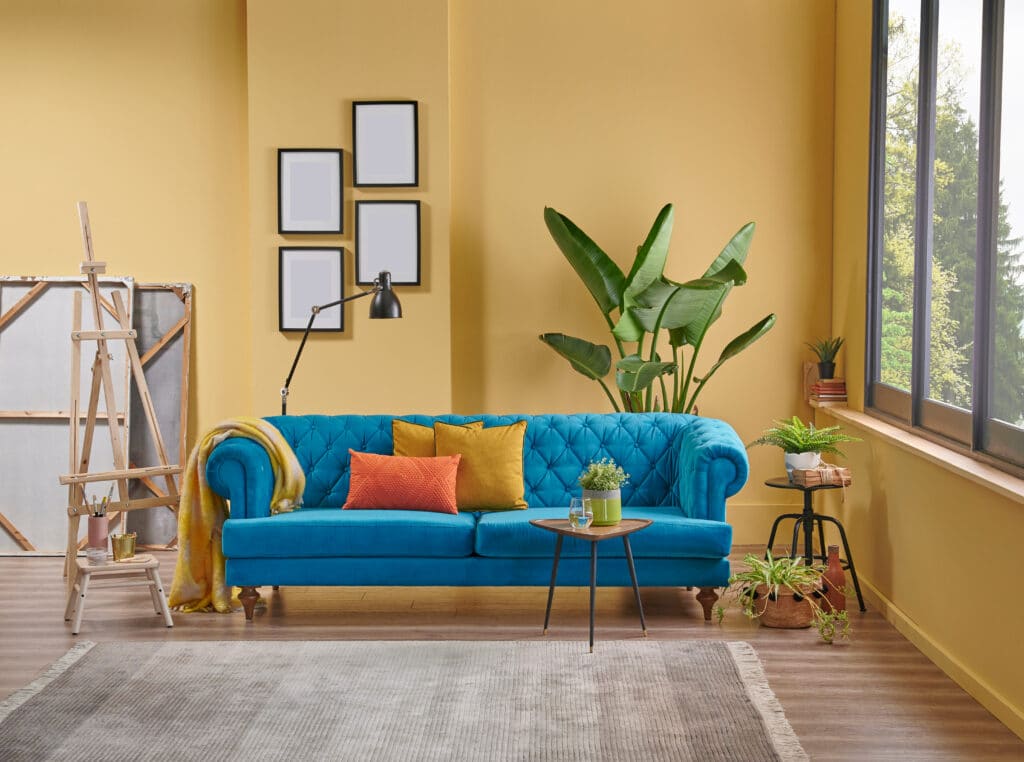
Each room is its own world, and no two rooms are alike when it comes to interior paint finishes. Each has unique challenges and requirements, influenced by factors such as natural light, foot traffic, and exposure to moisture, among others.
Choosing the right paint finish for each room is about balancing practicality, but how do we know which paint finish is best for which room? For instance, is eggshell or satin better for a living or dining room? Here’s how to approach interior paint finishes room by room:
Living Room, Family Room, and Dining Room
For areas like living and dining rooms, which often serve as central gathering spaces, using eggshell or satin finish is the best option:
- Eggshell provides a low sheen that adds warmth and is more washable than flat finishes, making it suitable for spaces with moderate traffic.
- Satin offers a bit more gloss and durability, making cleaning easier. This is beneficial for dining areas where spills might occur.
Kitchen
Kitchens are high-activity areas prone to moisture, grease, and frequent cleaning. A semi-gloss finish is ideal here due to its durability and ease of cleaning. Semi-gloss paints resist stains and can withstand the rigors of scrubbing, making them perfect for kitchen walls and cabinets.
Bathroom
Bathrooms experience high humidity and require finishes that can withstand moisture without deteriorating. Semi-gloss or high-gloss finishes are recommended for bathrooms as they offer excellent moisture resistance, are easy to wipe down and prevent mold and mildew growth.
Bedrooms
Adult bedrooms also differ from kids’ bedrooms:
- Adult bedrooms, where traffic is typically low, can benefit from using flat or matte finishes to create a calm and serene environment. These finishes provide a non-reflective surface that conceals wall imperfections.
- In children’s bedrooms, on the other hand, which may require more frequent cleaning, an eggshell or satin finish offers a balance between durability and a soft appearance.
Ceilings
Flat or matte finishes are commonly used for ceilings because they hide imperfections and provide a non-distracting surface. Since ceilings are less prone to touching and staining, the lower durability of flat paint is not an issue in these areas.
Trim and Woodwork
A semi-gloss or high-gloss finish is often preferred for trim, baseboards, and other woodwork. These finishes highlight architectural details and offer a durable surface that stands up well to cleaning and the occasional bump or scuff.
By understanding the types of paint finishes and tailoring them to the specific needs of each room, you can enhance your home’s beauty while ensuring practicality and longevity. By selecting the appropriate paint finishes for each room, owners can enhance the beauty of their homes while ensuring practicality and longevity. Here’s a comparative table to help guide the decision:
| Room/Area | Recommended Finish | Why? |
| Living Room, Family Room, Dining Room | Eggshell or Satin | Eggshell adds warmth and is washable; Satin offers more gloss and durability for moderate traffic areas. |
| Kitchen | Semi-Gloss | Durable and easy to clean, it resists stains and handles scrubbing. |
| Bathroom | Semi-Gloss or High-Gloss | Resists moisture, is easy to wipe down, and prevents mold and mildew. |
| Adult Bedroom | Flat or Matte | Creates a calm, serene atmosphere with non-reflective surfaces that hide imperfections. |
| Children’s Bedroom | Eggshell or Satin | Offers durability for frequent cleaning while maintaining a soft appearance. |
| Ceilings | Flat or Matte | Hides imperfections and minimizes glare; durability is less critical as ceilings are not exposed to wear and tear. |
| Trim and Woodwork | Semi-Gloss or High-Gloss | Highlights architectural details, offers a polished look, and provides a durable surface for areas prone to bumps and scuffs. |
Frequently Asked Questions on Interior Paint Finishes
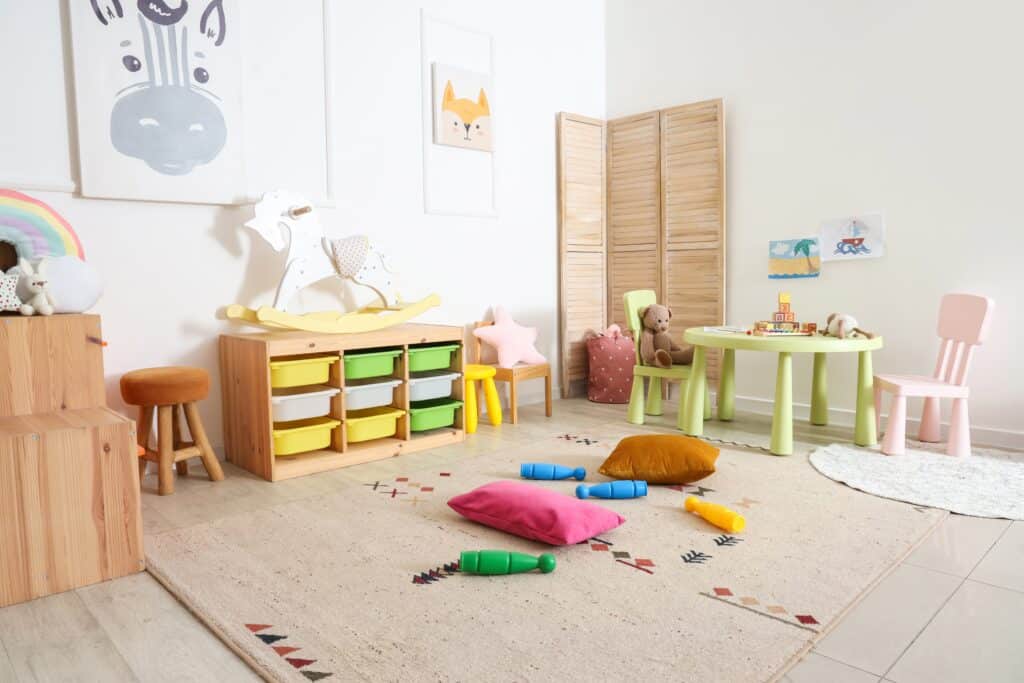
What is the best type of paint finish for interior walls?
Eggshell is the best choice for interior paint finishes. It perfectly balances durability and subtle elegance, offering just enough gloss to make walls look polished without being overpoweringly shiny. However, remember what we’ve said: each room is a world.
What type of finish is best for trim work?
Semi-gloss or high-gloss finishes are ideal for trim work. Both options highlight architectural details with a polished, refined appearance while offering a tough, durable surface that can withstand bumps, scuffs, and frequent cleaning. Semi-gloss provides a subtle shine, while high-gloss creates a striking, reflective look for maximum visual impact.
Can I use flat paint on walls?
Yes, flat paint is a great choice for walls, especially if they have imperfections like scuffs, nail pops, or uneven textures. Its non-reflective surface absorbs light, effectively camouflaging flaws and creating a smooth, uniform appearance. This makes it an excellent option for low-traffic areas where durability isn’t the top priority, such as adult bedrooms or ceilings. However, keep in mind that flat paint is harder to clean and may not hold up well in spaces that require frequent maintenance.
What’s the best paint for kids’ rooms?
Eggshell or satin finishes are ideal for kids’ rooms, offering durability for frequent cleaning while maintaining a soft, inviting look. Satin adds extra resilience and a slight sheen, perfect for high-activity spaces.
What paint should I use on the ceiling?
Flat or matte finishes are best for ceilings as they hide imperfections and minimize glare. Since ceilings aren’t exposed to wear and tear, durability isn’t a major concern, making these finishes ideal.
What type of paint is the easiest to clean?
Satin and semi-gloss finishes are the easiest to clean. Their smooth surfaces make it simple to wipe away dirt and stains with soapy water, making them perfect for high-traffic or messy areas.
Do paint sheens affect paint color?
Yes, paint sheens can affect how colors appear. Higher sheens reflect more light, making colors look brighter and more vibrant, while lower sheens absorb light, giving colors a softer, more subdued appearance.
Do paint sheens look different in the same lighting?
Yes, higher sheens like high-gloss and semi-gloss reflect more light, causing noticeable variations in appearance depending on the lighting. Matte finishes, on the other hand, provide a consistent look with minimal light reflection.
Discover the Koehn Painting difference – contact us today for a free estimate and step into a vibrant, freshly painted home!
